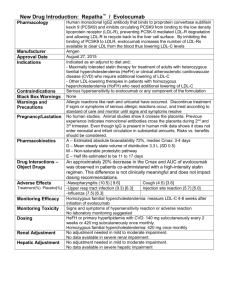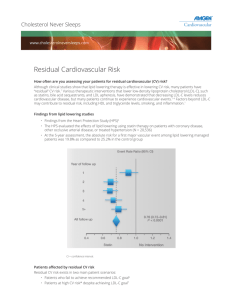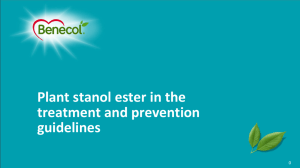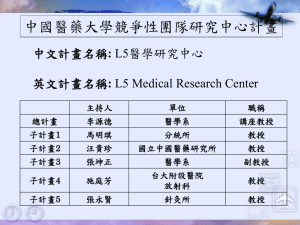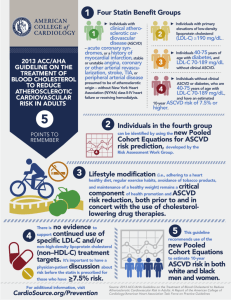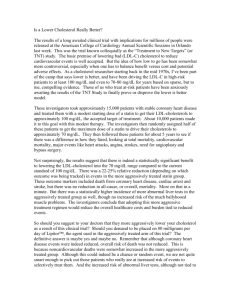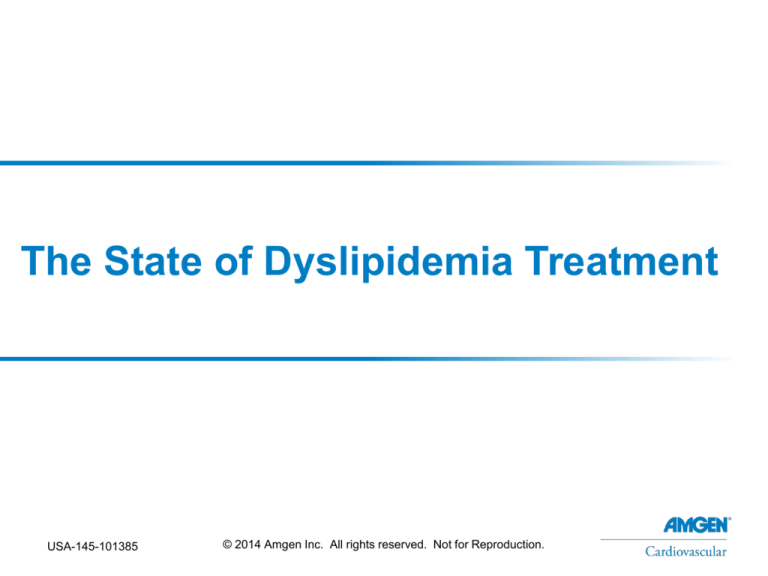
The State of Dyslipidemia Treatment
USA-145-101385
© 2014 Amgen Inc. All rights reserved. Not for Reproduction.
Table of Contents
Dyslipidemia
Mean Blood Cholesterol in the United
States Is Among Highest in the World
193 mg/dL
180–193 mg/dL
167–179 mg/dL
166 mg/dL
No data
WHO = World Health Organization. 1 mg/dL=0.0259 mmol/L
Adapted from WHO, Mean Blood Cholesterol in Males over 25 Years of Age, 1980–2008.
1. World Health Organization. Global Health Observatory (GHO). World Health Organization website.
www.who.int/gho/ncd/risk_factors/cholesterol_prevalence/en/. Accessed October 23, 2014.
Total Cholesterol Levels Increase During
Development and Remain Higher Than Those in
Hunter-Gatherer Populations
Distribution of Total Serum Cholesterol Levels in
~34,000 US Adults From NHANES III (1988–1994)
TC Changes During Fetal Development
Through Adulthood
Birth
High fat
Plasma TC (mg/dL)
Breast fed
200
150
100
Low fat
Formula
diet
50
0
Fetal
Nursing Infant
Adult
Developmental Period1
This information is meant to inform on levels
at different stages of human development
40
US Population (%)
250
Cholesterol levels
for modern huntergatherer populations
range from:3
101 mg/dL–146 mg/dL
50
Weaned
30
20
10
0
80 120 160 200 240 280 320 360 400
TC Level (mg/dL)2
Exact N is not available for Hunter-gatherer data, but is likely in the hundreds.
1. Adapted from Dietschy JM, et al. J Lipid Res. 2004;45:1375-1397. 2. Schwartz LM, Woloshin S. Eff Clin Pract. 1999;2:76-85. 3. Eaton SB, et al.
Am J Med. 1988;84:739-749.
LDL-C Levels Rise After Adulthood and Remain
Higher Than Those in Early Development
Mean LDL-C by Age
Average LDL-C Levels in the US
150
150
129
123
123
113
LDL-C (mg/dL)
Mean LDL-C (mg/dL)
124
116
100
100
83
49
50
48
50
28
0
33–34 41–42
Age:
In utero
(wk)1,c
n = 79
4–5
a
4–5
b
20–39 40–59 60–74
Infants
(mo)2
n = 18
Adults
(y)3,*
n = 8,174
0
1988-1994
aFormula
1999-2002
Years4,†
fed. bBreast fed. cUmbilical cord plasma concentrations
*NHANES trends in mean LDL-C serum levels of US adult respondents from 1999-2006, estimates are age adjusted to the 2000 standard US
population using the direct method. †Mean Age-adjusted LDL-C levels- approx. 15,000 US adults from NHANES (1988-2010)
1. Parker CR Jr, et al. Metabolism. 1983;32:919-923. 2. Wong WW, et al. J Lipid Res. 1993;34:1403-1411. 3. Cohen JD, et al. Am J Cardiol.
2010;106:969-975. 4. Carroll MD, et al. JAMA. 2012;308:1545-1554
2007-2010
Clinical Guidelines Recommend LDL-C
Lowering
ADA
Recommendations1
AACE
AACE
2
Guidelines
Guidelines2
IAS
ESC/EAS
ACC/AHA
Recommendations3
Guidelines4
Guidelines5,6
Targets LDL-C level
Targets
statin
therapy
intensity
ADA = American Diabetes Association; AACE = American Association of Clinical Endocrinologists; IAS = International Atherosclerosis Society;
ESC = European Society of Cardiology; EAS = European Atherosclerosis Society; AHA = American Heart Association; ACC = American College
of Cardiology
1. American Diabetes Association. Diabetes Care. 2014;37(suppl 1):S14-S80. 2. Jellinger PS, et al. Endocr Pract. 2012;18(suppl 1):1-78. 3. Grundy
SM, et al. J. Clin Lipidol. 2013;8:29-60. 4. Reiner Z, et al. Eur Heart J. 2011;32:1769-1818. 5. Stone NJ, et al. J Am Coll Cardiol. 2014;63:2889-2934.
6. Keaney JF, et al. N Engl J Med. 2014;370:275-278.
When Compared to Adult Treatment Panel III LDL-C
Goals, ~ 48 Million American Adults With High LDL-C
Were Not Treated or Not Adequately Treated
Prevalence, Treatment, and Control of LDL-C Based on NHANES 2005-2008*
US Adult Population
66.5%
at LDL-C
goal levels
without
cholesterollowering
medication†
71
million
(33.5%)
have
high
LDL-C†
US Adults With High
LDL-C
23 million
were treated
and at goal‡
37 million
are untreated
11 million were
treated, but not at
goal‡
*Extrapolated from data from 3,996 adults with high LDL-C aged ≥ 20 years in the National Health and Nutrition Examination Survey (NHANES) 20052008.†High LDL-C defined as > 160 mg/dL for low-risk adults; > 130 mg/dL for moderate-risk adults; and > 100 mg/dL for high-risk adults or the use of
cholesterol-lowering medication. ‡Adult Treatment Panel (ATP) III LDL-C goals: < 160 mg/dL for low-risk adults; < 130 mg/dL for moderate-risk adults;
and < 100 mg/dL for high-risk adults.
Kuklina EV, et al. Morbidity and Mortality Weekly Report. 2011;60:109-114.
A Substantial Percentage Do Not Achieve LDL-C
< 70 mg/dL Despite Maximal Statin Therapy
While on Maximal Statin Therapy The Percent of Patients Not Achieving
LDL-C < 70 mg/dL By Baseline LDL-C
100%
86%
LDL-C > 70 mg/dL
Maximal Intensity† (20 and 40 mg) of Statin 1
80%
74%
Maximal Intensity‡ (40 and 80 mg) of Statin 2
60%
51%
38%
40%
25%
18%
20%
0%
Baseline LDL-C
< 130 mg/dL
130-160 mg/dL
Individual patient data pooled meta-analysis, N=32,258 of 37 studies, comparing efficacy of various statins in At Risk Groups (VOYAGER). On
multivariate analysis, baseline lipid level (p < 0.0001) and increasing statin dose (p < 0.0001) were strong predictors of achieving treatment goals in high
risk patients.
Studies were identified by a comprehensive search of the Cochrane Controlled Trials Registry, Medline (1999-2007), EMBASE (1999-2007) Citeline
Trialtrove, and collection of all published research. Maximal intensity included average between two high dose groups of †20 and 40 mg of statin 1 and
‡40 and 80 mg of statin 2. High dose statin per ACC/AHA guidelines = statin 2, 40-80 mg; statin 1, 20-40 mg.
1. Nicholls SJ, et. al. Am J Cardiol. 2010; 105:69-76. 2. Stone NJ, et al. J Am Coll Cardiol. 2014;63:2889-2934.
> 160 mg/dL
Number of High Risk US Adults Achieving
LDL-C Levels of < 100 mg/dL or LDL-C Levels
of < 70 mg/dL, Respectively
90
At goal
Not at goal
80
Percent of Total
70
60
50
40
30
20
10
0
NHANES
Administrative
claims data
LDL-C < 100 mg/dL
EMR
NHANES
Administrative
claims data
LDL-C < 70 mg/dL
High-risk patients were defined as patients older than 18 years with a history of CHD or CHD risk equivalent who had the latest complete lipid panel
measurement and were treated with statin monotherapy for > 90 days.
EMR = electronic medical record database collected from 40,000 clinicians and 20,000 NP and PA (GE Centricity); Administrative Claims Database of
the medical and pharmacy claims for 42MM patients enrolled in a large US managed care plan (Clinformatics DataMart, a product of Optuminsight
Life Sciences); NHANES=National Health and Nutrition Examination Survey, a national public health survey conducted by the CDC of a nationally
representative sample of 5000 individuals each year across a country.
As per NCEP ATP III, the LDL-C goal patients was <100 mg/dL. High-risk patients were also evaluated for the optional goal of LDL-C <70 mg/dL, as
per the 2004 update to the NCEP ATP III Guidelines.
Jones, PH, et al. J Am Heart Assoc. 2012;1:e001800.
EMR
Multiple Causes Exist For Failure To
Achieve Desired LDL-C
• Patients with very high baseline1
• Adherence difficulties2
• Inability to tolerate optimal therapy3
• Limited access to optimal therapy1,4
• Insufficient/limited access to screening5
• Other causes
1. Pijlman AH, et al. Atherosclerosis. 2010;209:189-194. 2. National Cholesterol Education Program (NCEP). Circulation. 2002;106:3143-3421.
3. Cohen JD et al. J Clin Lipidol. 2012;6:208-215. 4. Elis A, et al. Am J Cardiol. 2011;108:223-226. 5. Kuklina EV, et al. CDC Morbidity and
Mortality Weekly Report. 2011;60:109-114.
Dyslipidemia in Diabetes
2009-2010 NHANES Data Show Those With
Diabetes Are NOT Achieving Desired Lipid Levels
Diabetes Population NOT
Achieving Desired Levels (%)
70%
61%
60%
50%
40%
39%
41%
HDL-C
TGs
30%
20%
10%
0%
LDL-C
LDL cholesterol goal: <70 mg/dL if CHD; <100 mg/dL if > 2 risk factors and Framingham risk score >20% or other previous CVD, diabetes, or chronic
kidney disease; <130 mg/dL if 2 risk factors or Framingham risk score 10% to 20%; <160 mg/dL if <2 risk factors and Framingham risk score <10%.
Risk factors include age, low HDL cholesterol, hypertension, smoking, and family history. HDL cholesterol normal levels: >40 mg/dL in men and >50
mg/dL in women. Triglyceride normal level: <150 mg/dL.
Wong ND, et al. Am J Cardiol. 2013;112:373-379.
A Substantial Number of People With
Diabetes Have High LDL-C
Individuals With Diabetes
Individuals With Diabetes
and Cardiovascular Disease
28%
43%
57%
72%
< 100 mg/dL LDL-C
< 70 mg/dL LDL-C
> 100 mg/dL LDL-C
> 70 mg/dL LDL-C
Data shown are from 3,355 adults in the National Health and Nutrition Examination Survey (NHANES) with a diagnosis of diabetes from a health care
professional, and 97,310 adults who reported having diabetes from the Behavioral Risk Factor Surveillance System (BRFSS) survey. Data is from 2007-2010.
(P<0.001)
Ali MK, et al. N Engl J Med. 2013; 368:1613-1624.
Dyslipidemia in Familial
Hypercholesterolemia
Familial Hypercholesterolemia Phenotypes
FH Heterozygotes
FH Homozygotes
~ 1 in 200 to 1:500 persons worldwide1,4
~ 1 in 1,000,000 persons worldwide1
1 mutated allele1
2 mutated alleles1
TC: 350 to 500 mg/dL3
TC: > 500 to > 1,000 mg/dL1
LDL-C: 200–400 mg/dL1,2
LDL-C: > 600 mg/dL2
Half the number of LDLR expressed3
LDLR activity absent or dysfunctional3
TC = total cholesterol
1. Rader DJ, et al. In: Longo DL, et al, eds. Harrison’s Principles of Internal Medicine. Vol II.18th ed. New York, NY: McGraw Hill Medical.
2012:3145-3161. 2. Robinson JG. J Manag Care Pharm. 2013;19:139-149. 3. National Cholesterol Education Program (NCEP) Expert Panel on
Detection, Evaluation, and Treatment of High Blood Cholesterol in Adults (Adult Treatment Panel III). Circulation. 2002;106:3143-3421.
4. Nordestgaard BG, et al. European Heart Journal. 2013;34:3478–3490.
Familial Hypercholesterolemia
Mother
Father
Offspring
X
FH Heterozygotes
FH Homozygote
• 1 in 200 to 1:500 in most populations
• Half-normal number of LDL receptors
• 2-fold increase in plasma LDL
• 1 in 1 million population
• Absent or dysfunctional LDL receptors
• 6- to 10-fold increase in plasma LDL
Goldstein JL, et al. Arterioscler Thromb Vasc Biol. 2009;29:431-438. Nordestgaard BG, et al. European Heart Journal. 2013;34:3478–3490.
Multiple Genetic Defects Causing Changes in
Lipoprotein Metabolism Can Be Associated With
Familial Hypercholesterolemia (FH)*
16.7%
Others
14%
ApoB
2.3%
PCSK9
67%
LDLR
*Autosomal Dominant Hypercholesterolemia.
LDLR = LDL receptor; PCSK9 = Proprotein Convertase Subtilisin Kexin Type 9; ApoB = apolipoprotein B
Seidah NG, et al. J Mol Med. 2007;85:685-696.
Diagnosis of FH in the US is Approximately
<1% of Estimated Prevalence
Estimated percent of individuals diagnosed with FH in different countries/territories*
*As a fraction of those theoretically predicted based on a frequency of 1/500 in the general population. As most countries do not have valid
nationwide registries for FH, several values represent informed estimates from clinicians/experts in their respective countries.
Nordestgaard BG, et al. European Heart Journal. 2013; 34: 3478-3490
Despite Maximal Treatment, A Low Percentage of
Patients with HeFH Achieve LDL-C < 100 mg/dL
% of Patients Achieving LDL-C Goal
Per Risk Category
In a Randomized Global Clinical Trial of HeFH
Patients, A Low Percentage Achieved LDL-C Levels
of < 100 mg/dL on Maximal Treatment*
100%
In Netherlands Estimates of HeFH Patients On
Maximal Lipid Lowering Therapy Achieving
LDL-C < 100 mg/dL**
< 100 mg/dL
> 100 mg/dL
Statin 1
Statin 2
80%
†p
60%
40%
< 0.05,
n = 103
14%
n = 37
‡p
< 0.001,
n = 155
20%
86%
n = 67
0%
<130 mg/dL
<100 mg/dL
*NCEP Adult Treatment Panel III Risk Category: Medium Risk: <130 mg/dL (3.4 mmol/L); ≥ 2 risk factors,10-year risk of coronary artery disease ≤ 20%;
High Risk: <100 mg/dL (2.6 mmol/L); coronary artery disease or its risk equivalents (atherosclerosis, diabetes, or 10-year risk > 20%).18 week RCT,
double-blind parallel group where heterozygous (He) FH patients initiated statin treatment at 20 mg with forced titration to 40 and 80 mg in 1999-2000.
N = 623 randomized; p Values were obtained from a logistic regression model . Global population consisted of 31% US patients.
**Adults with HeFH were part of a cross-sectional study. 96% were on statin treatment where 34% were on maximum dose. N = 1249 met inclusion
criteria. n = 304 patients on maximal therapy; Maximum lipid-lowering therapy was defined as maximum statin doses in combination with ezetimibe.
Using outpatient visits to Lipid Clinics after February 2006.
1. Stein EA, et al. Am J Cardiol. 2003; 92:1287-1293. 2. Pijlman AH, et al. Atherosclerosis. 2010; 209:189-194.


